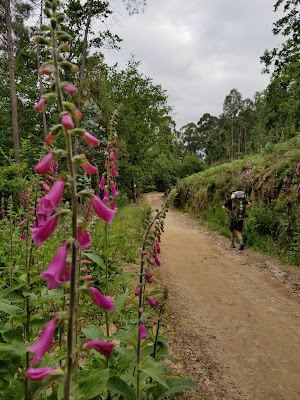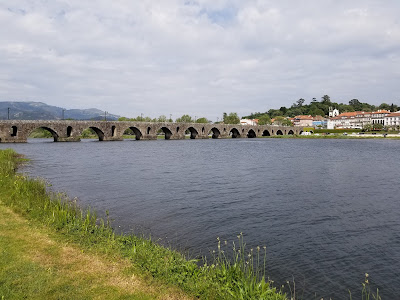Roman Legions and Medieval Bridges : Valinhas to Ponte da Lima
Roman Legions and Medieval Bridges
Camino Portuguese Pilgrimage
Today we slept in until around 6 AM, and then made a leisurely start, heading out into a cool, overcast morning. We walked about two kilometres to the first cafe, where we stopped for coffee and chocolate croissants. We were soon joined by the lovely German couple who had walked to Santiago from their home, and later on we were joined by a few additional pilgrims.
After breakfast, we continued on through a lovely forested section of track. It was filled with cala lilies and other wildflowers that seemed to have opened in the last few days. We have been enjoying the more relaxed, quieter, rural nature of the trail since Porto.
After this section, the Camino mostly consisted of paved or cobblestone lanes between short stone walls, on the other side of which were vineyards, houses with wonderful flower-filled gardens, or fields of wildflowers, some with sheep and horses. As we hiked we passed quite a few families on their tractors or working the fields and vineyards by hand, with hoes. Some seemed to have wagons of freshly harvested potatoes, which is definitely a spring crop in Canada.
The villages have taken on a different feel here too - gone are the stucco walls topped with ornamental metal fences and decorated with tiles. Now the buildings and walls are mostly field stone, which looks similar to the granite shield in North America, rather than the yellow sandstone we saw farther south. The stone structures here are almost reminiscent of the buildings we saw in Galicia, Spain.
Camino Chapels
Today we passed quite a few small stone chapels and many shrines. Since Porto many of the tile roadside shrines have been dedicated to S. Tiago, but even here quite a few honour Santo Antonio, who must be special to the Portuguese.
Along the Way, we also started to see quite a few fancy drinking fountains with potable water, which is a change from before Porto where we had to refill our water bottles in local bars or cafes. We also passed quite a few shaded pilgrim rest areas on the sides of the road.
Along the Way, we also started to see quite a few fancy drinking fountains with potable water, which is a change from before Porto where we had to refill our water bottles in local bars or cafes. We also passed quite a few shaded pilgrim rest areas on the sides of the road.
Ponte da Lima Portugal
The landscape has also subtly changed, and it is clear that the rolling hills of wine country are inhabited by wealthy occupants. The estates are large and well maintained, there are fewer obviously abandoned buildings, and the pilgrim accommodations are now in the 4-5 star range by the looks of their outsides.
Around 10:30 AM we reached Ponte da Lima, where we had decided to stay the night based on the guidebook's glowing description of the medieval town and bridge. We approached the town along the river, where we stopped to watch birds fishing at the weir. As we stood there Sue and Peter passed by, and then Heimy reappeared, which was very exciting! A number of other pilgrims we've been walking with also seemed attracted to the river and stopped by for a chat.
We continued into town by way of a spectacular tree-lined promenade. The disconcerting thing about the majestic approach was that there was music being broadcast from the lampposts! As we would discover later, different parts of the city have soundtracks (marching music to cross the river, and modern dance music in one of the squares).
We had booked into an inexpensive room for the night at Hotel Imperio do Norte so that Sean could photograph the town after the 10 PM albergue curfew. Luckily and unexpectedly our room was ready when we arrived, so we were able to check in, do chores, and head back out to explore without our packs.
We began by visiting the church, which seems to consist of several different architectural styles. We then climbed the tower above the tourist center, where there is an art exhibit by local students (I think).
After that, we wandered the streets a little, crossed the iconic medieval bridge over the Rio Lima, and then visited the chapel on the other side. As we wandered we started to notice signs of a Bavarian or German influence - brightly coloured clogs and decorated beer steins in the tourist shops, a statue of an accordion player in the square, and other statues of women dressed in almost Bavarian-looking costumes. We also hear more German being spoken in the streets than English. It made us wonder what the history of this town is.
As we made our way down along the river we came across a display of plastic and wooden Roman legionaries, as well as a statue of a Roman soldier on a white stallion. Combined with the broadcast music, these touches seem to me to give the town the atmosphere of an amusement park.
We headed back to the square and had a drink and a cheese plate, while Peter and Sue sat with us, waiting until the municipal albergue opened at 4 PM. Remaining at the restaurant we later enjoyed an early dinner as the town site emptied out of tour buses.
After the short break, we headed back across the river to see if we could visit the gardens. As it turned out they were closed, along with all the museums and tourist attractions. At least our streak of finding Portuguese sites closed is consistent.
We walked the river footpath in both directions, looking at birds and enjoying the river. It is a picturesque town, on the edge of a beautiful river, with lovely mountains covered in yellow broom flowers in the background. It is kind of too bad it is so touristy.
Accommodations: Hotel Imperio do Norte
Distance: 14.7 km
We continued into town by way of a spectacular tree-lined promenade. The disconcerting thing about the majestic approach was that there was music being broadcast from the lampposts! As we would discover later, different parts of the city have soundtracks (marching music to cross the river, and modern dance music in one of the squares).
We had booked into an inexpensive room for the night at Hotel Imperio do Norte so that Sean could photograph the town after the 10 PM albergue curfew. Luckily and unexpectedly our room was ready when we arrived, so we were able to check in, do chores, and head back out to explore without our packs.
We began by visiting the church, which seems to consist of several different architectural styles. We then climbed the tower above the tourist center, where there is an art exhibit by local students (I think).
After that, we wandered the streets a little, crossed the iconic medieval bridge over the Rio Lima, and then visited the chapel on the other side. As we wandered we started to notice signs of a Bavarian or German influence - brightly coloured clogs and decorated beer steins in the tourist shops, a statue of an accordion player in the square, and other statues of women dressed in almost Bavarian-looking costumes. We also hear more German being spoken in the streets than English. It made us wonder what the history of this town is.
As we made our way down along the river we came across a display of plastic and wooden Roman legionaries, as well as a statue of a Roman soldier on a white stallion. Combined with the broadcast music, these touches seem to me to give the town the atmosphere of an amusement park.
We headed back to the square and had a drink and a cheese plate, while Peter and Sue sat with us, waiting until the municipal albergue opened at 4 PM. Remaining at the restaurant we later enjoyed an early dinner as the town site emptied out of tour buses.
After the short break, we headed back across the river to see if we could visit the gardens. As it turned out they were closed, along with all the museums and tourist attractions. At least our streak of finding Portuguese sites closed is consistent.
We walked the river footpath in both directions, looking at birds and enjoying the river. It is a picturesque town, on the edge of a beautiful river, with lovely mountains covered in yellow broom flowers in the background. It is kind of too bad it is so touristy.
See
you on the Trail!
_________________________________________Accommodations: Hotel Imperio do Norte
Distance: 14.7 km



























































Comments
Post a Comment